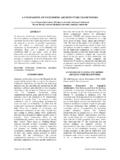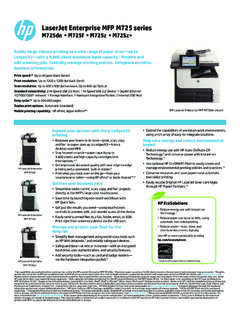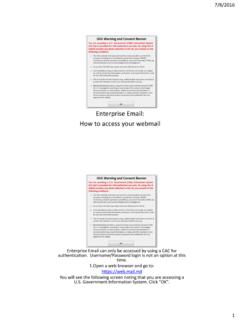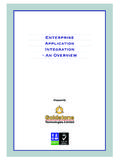Transcription of Technologies for the Virtual Enterprise
1 Technologies for the Virtual Enterprise Martin Ader, Workflow & Groupware Strategies, France The development of the Internet, coupled with the development of Technologies for Knowledge Management and Work Management, will have deep influence on the way economic actors play their role in the worldwide market place. This will lead to the development of a new form of economic undertaking, the Virtual Enterprises where sets of economic actors are associating their strengths to provide a specific service traditionally provided by a single Enterprise . Such a possibility will have, in the long term, deep influence on the economy and Enterprise development strategies. The purpose of this chapter is to show how this can modify the way work can be organized and conducted, to demonstrate how those effects enable competition between Virtual enterprises and traditional ones, and finally to give an overview of the conditions to make it happen.
2 FOREWORD The development of Internet, coupled with the development of Technologies for Knowledge Management on one side, and Work Management on the other side, will have deep influence on the way economic actors play their role in the worldwide market place. This will lead to the development of a new form of economic undertaking where sets of economic actors are associating their strengths to provide a specific service traditionally provided by a single Enterprise . Such a possibility will have, in the long term, deep influence on the economy and enterprises development strategies: 1. Launching a new product or service on the market will become accessible to much smaller organizations with a portion of the capital required in a traditional way.
3 This will intensify competition on traditional organizations. 2. Localization of partners of the Virtual Enterprise will become irrelevant; this will accelerate the international co-operation and intensify work mobility between countries and areas. 3. Overall, this will accelerate product and services diversification and innovation, a condition for further economic development. 4. Traditional organizations will have to face emerging competition from non-traditional competitors, and will probably have to invent new ways to organize their production. The purpose of this article is: To describe how new Technologies can affect working conditions To show how this can modify the way work can be organized and conducted To demonstrate how those effects make possible competition between Virtual enterprises and traditional ones To outline the possible scenario for the creation of a Virtual Enterprise And finally to give an overview of the conditions to make it happen.
4 We will first present an overview of Knowledge Management and Work Management Technologies and how the Internet will favor their development. Then we will further elaborate on Workflow, the most important technology in our opinion. We will show how traditional Enterprise can take benefits of those evolutions. And then how those tools can promote the development of Virtual enterprises. Finally, we will give guidelines on how information systems can be modelled to take maximum benefits of those new possibilities. NEW Technologies We can classify major Technologies into three main areas of applications: Knowledge Management (KM) Technologies that provide the way to share and organize strategies, research and development, market research, and so on.
5 Technologies FOR Virtual ENTERPRISES 2 Enterprise Resource Planning (ERP); represented by application from vendors like SAP, People Soft, and Baan. They are used for traditional accounting like activities: accounting, inventory management, sales statistics, etc. Work Management (WM) Technologies provide assistance to groups work, and enhance productivity and quality of work. They are used to assist day-to-day production work. KNOWLEDGE MANAGEMENT Knowledge Management (KM) Technologies are a collection of tools designed to store and retrieve knowledge. They include such tools as: Document Management to store and retrieve documents. Data Ware Houses and Data Mining tools to store and analyze data coming from accounting based applications.
6 Full text indexing and search agents, basis of search engines as known today on the Internet, to search documents based upon their content. KnowledgeManagementDataMiningDocumentMan agementSearchAgentsDataWare housesFull textIndexingIntelligentDocumentretrieval ThesaurusSemanticNetworksLinguisticTools Figure 1 Knowledge Management Technologies Thesaurus to enable intelligent search on full text indexes by storing terms hierarchies, relationships and similarities. Linguistic tools to support natural language queries. Semantic networks to store meaning of documents as a network of actions on objects and enable powerful searches on a document based on network patterns matching ( all documents speaking about transforming materials under high temperature conditions).
7 Intelligent document retrieval tools with learning capabilities of both the user interest, and the target systems delivering capabilities. As said before, these tools are used for understanding the market place, and the possibilities that are offered in various areas, in order to take better decisions, orient product definition, organize production, enhance sales activities efficiency, and so on. WORK MANAGEMENT Work Management Technologies are a collection of tools designed to assist production work. They include such tools as: E-mail, which accelerates communication between people, and can monitor basic question and answer cycles. Meeting scheduling, which assists a group in organizing and planning collective activities, as well as sharing common resources.
8 Forum, which provides a shared space to a group for structured discussions and document base. EXCELLENCE IN PRACTICE VOLUME III 3 WorkManagementDocumentManagementCollabor ationWorkflowForumGroupwareMeetingSchedu lingE-mail Figure 2 Work Management Technologies Collaboration tools, which provide a group the means to edit collectively in real time documents of many different forms (specifications, contracts, planning, budgets, proposals, etc.) Groupware, which combines above tools in a uniform environment, ready to use by groups. Document Management, which stores large quantities of documents in an organized way, and maintain versions, renditions, indexes and so on. Workflow, that supports business processes for their whole lifetime.
9 Those tools are used to assist the work done for producing products and services. In contrast with KM tools that are used to decide what to produce and how to produce it. INTERNET Internet provides essentially two features: HTML, a multimedia presentation protocol, enabling the definition of pages containing multimedia elements as well as forms fields. HTML is very simple and enables presentation tools (web browsers) and edition tools (HTML editors) at reasonable cost. URL, a universal service identification, able to locate anywhere in the network an HTML page, or a program invocation (CGI call). Thanks to these features, Internet provides a very easy to use interface, and a set of tools to support it at low cost. More important, any page or application created and stored using Internet standards can be seen or activated from any workstation connected to Internet, anywhere in the world.
10 Today, everyone is likely to agree on the fact that Internet is a major technological revolution that every company needs to consider. However, even three years ago it was not like that. Internet deployment around the world both at public and professional levels is the fastest technological evolution of this century. The Internet will connect 200 million users in the year 2000, and perhaps one billion in 2010. Within the past two or three years, the whole computer and telecommunication industries have redeployed their development and marketing forces to provide tools and services on the Internet, to enhance its infrastructure and standards and provide supporting products. The level of investment is unprecedented and has now gone far beyond the point of no return.









